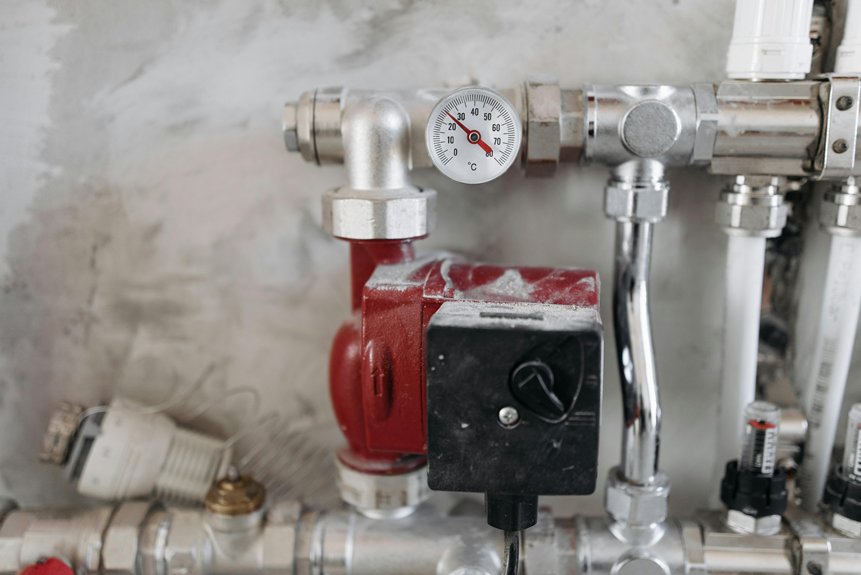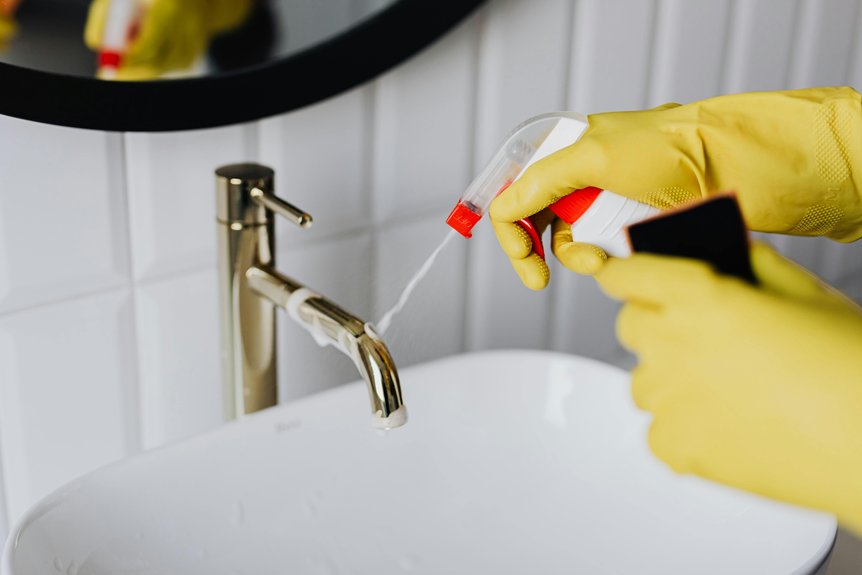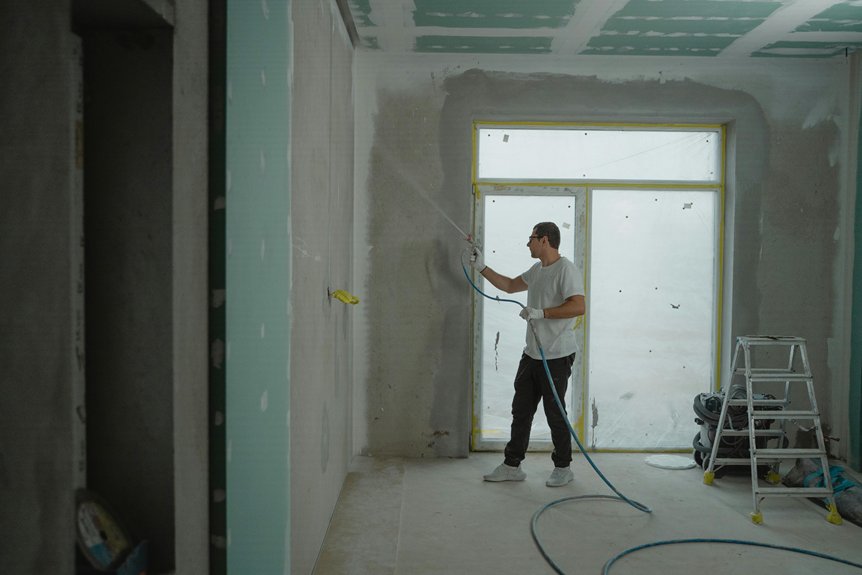When it comes to maintaining your home, seasonal tasks shouldn’t be overlooked. Regular inspections and upkeep can prevent costly repairs down the line. From gutters to HVAC systems, each area plays an important role in your home’s integrity and comfort. If you’re ready to tackle these essential tasks, you’ll want to know exactly what steps to take to guarantee everything functions smoothly. Let’s break down the key items on your checklist.
Key Takeaways
- Inspect and clean gutters and downspouts to prevent water damage and ensure proper water flow.
- Schedule HVAC checkups and replace air filters every one to three months for optimal air quality and efficiency.
- Test smoke and carbon monoxide detectors monthly, replacing batteries or outdated devices as needed for safety.
- Conduct thorough plumbing inspections, checking for leaks and ensuring all drains are clear and functioning properly.
- Prepare for seasonal changes by inspecting roofing, seals, and outdoor furniture while trimming trees and cleaning walkways.
Inspect and Clean Gutters and Downspouts

As autumn approaches, it’s crucial to inspect and clean your gutters and downspouts to prevent water damage to your home.
Start by removing leaves and debris to guarantee proper water flow. Check for any signs of rust or damage, which could indicate the need for downspout repairs. Clear clogs promptly and consider installing gutter guards to minimize future maintenance.
Regular gutter maintenance not only extends the lifespan of your system but also protects your foundation from water pooling.
Regular gutter maintenance safeguards your home by prolonging system life and preventing foundation damage from water pooling.
Don’t overlook this important task; a few hours spent now can save you from costly repairs later.
Check and Replace Air Filters
Checking and replacing your air filters is essential for maintaining good indoor air quality and ensuring your HVAC system runs efficiently.
Ideally, you should replace filters every one to three months, depending on usage and filter type.
Clean filters not only help reduce allergens but also improve your system’s performance, saving you money on energy costs.
Importance of Clean Filters
While you mightn’t think about air filters often, keeping them clean is essential for your home’s efficiency and air quality.
Regular filter maintenance guarantees that your HVAC system runs smoothly, reducing energy consumption and lowering utility bills. Clogged filters can trap dust, allergens, and other pollutants, leading to poor indoor air quality that can affect your health.
By checking and replacing filters regularly, you not only enhance airflow but also prolong the lifespan of your heating and cooling systems.
Prioritizing clean filters is a simple yet effective way to create a healthier living environment for you and your family.
Replacement Frequency Guidelines
To maintain ideal air quality and system efficiency, it’s crucial to establish a regular schedule for checking and replacing your air filters.
Generally, you should aim for seasonal replacements, ideally every three months. If you have pets or live in a dusty area, consider changing them monthly.
Always consult your HVAC system’s manual for specific frequency guidelines, as different systems may have unique needs.
Regularly inspecting your filters not only promotes cleaner air but also enhances your system’s performance and longevity.
Test Smoke and Carbon Monoxide Detectors
Ensuring your smoke and carbon monoxide detectors are functioning properly is essential for your home’s safety. Start by conducting regular detector testing every month.
Press the test button on each unit to confirm they sound an alarm. If not, replace batteries or consider replacing the detectors entirely if they’re older than ten years.
Also, check that detectors are installed in key locations, such as near sleeping areas and on every level of your home.
Taking these safety precautions can greatly reduce the risk of fire or carbon monoxide exposure, keeping you and your loved ones protected year-round.
Service Heating and Cooling Systems
After checking your smoke and carbon monoxide detectors, it’s time to turn your attention to your heating and cooling systems.
Schedule a seasonal HVAC checkup to guarantee everything’s running smoothly. Start with heat pump maintenance; clean or replace filters and check for any signs of wear.
Inspect the outdoor unit for debris and make sure it’s clear for maximum airflow. Don’t forget to check thermostat settings for accuracy.
This proactive approach not only enhances efficiency but also prolongs the lifespan of your systems.
Inspect Roof for Damage
Climb up to your roof and inspect it for any signs of damage, especially after severe weather events.
Start your roof inspection by checking for missing, cracked, or curled shingles. Look for any loose flashing around vents and chimneys, as these can lead to leaks.
Begin your roof inspection by examining shingles for damage and checking for loose flashing around vents and chimneys to prevent leaks.
During your damage assessment, pay attention to sagging areas or water stains inside your home, indicating potential issues.
Don’t forget to examine your gutters for debris that could cause water backup.
If you notice significant damage, consider contacting a professional to guarantee your roof remains in top condition and protects your home effectively.
Seal Windows and Doors
As the seasons change, sealing your windows and doors becomes essential to maintaining your home’s energy efficiency and comfort.
Start by inspecting existing weather stripping for wear and tear; replace any damaged sections to prevent drafts. You can use caulk to fill gaps around frames, ensuring a tight seal. Pay special attention to corners and edges where air leakage often occurs.
Additionally, consider installing storm windows for extra insulation in colder months.
Clean and Organize the Garage
With your windows and doors sealed, it’s time to turn your attention to the garage—a space that often becomes cluttered and disorganized.
Start by clearing everything out, then sort items into keep, donate, and discard piles. For effective garage organization, consider using vertical storage solutions like shelves or pegboards to maximize space.
Clear bins are excellent for storing seasonal items, allowing you to easily see what you’ve got. Don’t forget to label containers for quick access.
With a clean and organized garage, you’ll not only enhance functionality but also create a more inviting environment for your seasonal activities.
Maintain Landscaping and Lawn Care
While the changing seasons can bring beauty to your landscape, they also require diligent maintenance to keep your lawn and garden thriving.
Start by implementing effective lawn fertilization techniques to encourage healthy growth. Regular mowing and watering are essential, too.
Don’t forget to enhance your garden with seasonal flower planting; this adds color and vibrancy.
- Test soil quality for ideal nutrient balance.
- Choose native plants that thrive in your climate.
- Create a seasonal schedule for maintenance tasks.
Check for Pests and Rodents
As the seasons change, it’s essential to inspect your home for any entry points that pests and rodents might exploit.
Look for gaps around windows, doors, and foundations, sealing them to keep unwanted guests out.
If you suspect an infestation, set traps strategically in areas where you’ve noticed signs of activity to effectively manage the situation.
Inspect for Entry Points
To keep your home safe and comfortable, it’s essential to inspect for entry points that pests and rodents might exploit.
Start with a thorough entry point assessment to identify any vulnerabilities in your home’s exterior.
Consider these key areas:
- Gaps around windows and doors: Seal any openings with weatherproofing strategies.
- Cracks in the foundation: Fill these gaps to deter unwanted guests.
- Vents and utility lines: Make certain these areas are securely covered.
Set Traps Strategically
Setting traps strategically is an essential step in keeping pests and rodents at bay.
To maximize your pest control efforts, focus on trap placement in high-traffic areas like kitchens, basements, and near entry points. Use bait that attracts the specific pests you’re targeting.
Consider using snap traps for rodents and sticky traps for insects. Check your traps regularly, and be prepared to relocate them if they aren’t effective.
Always follow the manufacturer’s guidelines for safe usage. By being proactive and methodical in your approach, you’ll create an effective barrier against unwanted critters in your seasonal home.
Flush Water Heater and Check Plumbing

Flushing your water heater at least once a year is crucial for maintaining its efficiency and extending its lifespan.
This process helps remove sediment buildup that can affect performance.
Don’t forget to also conduct thorough plumbing inspections to catch potential issues early.
- Check for leaks around all fixtures.
- Inspect hoses and connections for wear.
- Verify all drains are clear and functioning.
Conclusion
By tackling these 10 essential tasks, you’re not just maintaining your home; you’re safeguarding your investment and ensuring a safe, comfortable environment for your family. From cleaning gutters to servicing HVAC systems, each step plays a crucial role in enhancing your property’s longevity. Don’t wait for problems to arise—make seasonal maintenance a priority. With a little time and effort, you can keep your home in top shape, ready to face whatever the seasons bring.




